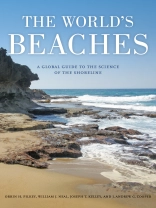Take this book to the beach; it will open up a whole new world. Illustrated throughout with color photographs, maps, and graphics, it explores one of the planet’s most dynamic environments—from tourist beaches to Arctic beaches strewn with ice chunks to steaming hot tropical shores.
The World’s Beaches tells how beaches work, explains why they vary so much, and shows how dramatic changes can occur on them in a matter of hours. It discusses tides, waves, and wind; the patterns of dunes, washover fans, and wrack lines; and the shape of berms, bars, shell lags, cusps, ripples, and blisters. What is the world’s longest beach? Why do some beaches sing when you walk on them? Why do some have dark rings on their surface and tiny holes scattered far and wide? This fascinating, comprehensive guide also considers the future of beaches, and explains how extensively people have affected them—from coastal engineering to pollution, oil spills, and rising sea levels.
The World’s Beaches tells how beaches work, explains why they vary so much, and shows how dramatic changes can occur on them in a matter of hours. It discusses tides, waves, and wind; the patterns of dunes, washover fans, and wrack lines; and the shape of berms, bars, shell lags, cusps, ripples, and blisters. What is the world’s longest beach? Why do some beaches sing when you walk on them? Why do some have dark rings on their surface and tiny holes scattered far and wide? This fascinating, comprehensive guide also considers the future of beaches, and explains how extensively people have affected them—from coastal engineering to pollution, oil spills, and rising sea levels.
Table of Content
Dedication Page (Santa Aguila Foundation)PREFACE
(ACKNOWLEDGMENTS)
LIST OF ILLUSTRATIONS
LIST OF TABLES
Part I: THE GLOBAL CHARACTER OF BEACHES
Chapter 1: A WORLD OF BEACHES
Beaches: Crossroads of History
Beaches: Avenues of Commerce
Beaches: Nature’s Most Dynamic Environment
Beaches: Varied Materials
Beaches: Obstacle Courses
Beaches: To Be or Not To Be
Beaches: Comber’s Delight or Nature’s Trash Collector?
Beaches: A Natural Laboratory
Chapter 2: BEACHES OF THE WORLD
What is a Beach?
Recipe for Making a Beach
Classification of Coasts and Beaches
Classifications and a Global Model
Beach Sediments and the Plate Tectonic Setting
Beaches as Landforms
Climate and Types of Coasts
We Stand on Their Shoulders
Chapter 3: OF WHAT ARE BEACHES MADE: SEDIMENTS
Beach Sediments
Grain Size, Sorting and Shape
Grain Composition
Terrigenous Sediments
Heavy Minerals
Carbonate Sediments
Other Beach Materials
Chapter 4: HOW BEACHES WORK: WAVES, CURRENTS, TIDES AND WIND
The Most Dynamic Place on Earth
Waves
Wave Energy
Wave Types
Breakers
Wave Refraction, Diffraction and Reflection
Currents (Alongshore; Onshore; Offshore)
Wave-Current-Sediment Interaction
Tsunamis
Tides
Tides and Beach Groundwater
Other Water Level Changes
Surges
El Niño
Wind
The Global Picture
Chapter 5: THE FORM OF THE BEACH: CRABS-EYE AND BIRDS-EYE VIEWS
Beach Profiles: The Crab’s Eye View
Profile Changes
Beach Plans: The Bird’s Eye View
Berms and Cusps
Washover Fans
Offshore Bars
Part II: HOW TO READ A BEACH
Chapter 6: THE BEACH SURFACE UP-CLOSE: IMPRINTS OF TIDES, CURRENTS, AND WAVES
Near-Shore, Beach, and Tidal Flat Features
Ripple Marks
Modified Ripple Marks
Swash and Backwash Features
Other Surface Features
Chapter 7: ESCAPE FROM WITHIN: AIR AND WATER IN THE BEACH
Knee Deep in Sand: Airy Beaches
Air Escape Structures
Watery Beaches and Water Escape Structures
Chapter 8: WHICH EVER WAY THE WIND BLOWS: REWORKING THE BEACH SURFACE
Wind on Wet Sand and Mud
Wet-to-Dry Transition Structures
Wind on Dry Sediment
Dunes and Dune Structures
Dune Plants: Surviving in a Desert
Chapter 9: BEACH CREATURES: TRACKS, TRAILS, AND TRACES
Beach Animals from Micro to Macro
Macrofaunal Clues
Molluscs (clams and snails)
Crustaceans
Chelicerata
Polychaetes
Other Invertebrate Animals
Vetebrates
Evidence of the Habitat Role of Animals
Chapter 10: CARBONATE BEACHES: SEA SHELLS AND THE STORIES THEY TELL
Carbonate Shells, Skeletons, and Secretions
Other Carbonate Sediments
Non-Calcareous Plant and Animal Remains
Shell Abundance
Where do Seashells Come From?
The Significance of Broken Seashells
Shell Rounding
Orientation of Shells on the Beach
Secondary Shell Color
Shell Collecting: An Environmental Afterthought
Chapter 11: DIGGING THE BEACH: INTO THE THIRD DIMENSION
Bedding
Black Sands and Cross Bedding
Burrows and Bioturbation
Part III: THE GLOBAL THREAT TO BEACHES
Chapter 12: BEACHES AND PEOPLE
Coastal Engineering
Hard Stabilization
Soft Stabilization
Other Damaging Activities
Water Pollution
Oil Spills
The Environmental Truths About Beaches
Chapter 13: EPILOGUE
The Urbanized Beach: From Middens to the Maelstrom of Development
GLOSSARY
REFERENCES
About the author
Orrin H. Pilkey is the James B. Duke Professor of Earth and Ocean Sciences and Director Emeritus of the Program for the Study of Developed Shorelines at Duke University. He is the author of A Celebration of the World’s Barrier Islands, among other books. William J. Neal is Emeritus Professor of Geology at Grand Valley State University and coauthor, with Orrin Pilkey, of How to Read a North Carolina Beach: Bubble Holes, Barking Sands, and Rippled Runnels. Joseph T. Kelley is a Professor of Marine Geology at the University of Maine and Chair of the Earth Science Department. He is a co-author with Orrin Pilkey and William Neal of Atlantic Coast Beaches. Andrew Cooper is Professor of Coastal Studies and head of Coastal Research in the School of Environmental Sciences at the University of Ulster in Northern Ireland.
Language English ● Format EPUB ● Pages 302 ● ISBN 9780520948945 ● File size 11.4 MB ● Publisher University of California Press ● Published 2011 ● Edition 1 ● Downloadable 24 months ● Currency EUR ● ID 5511566 ● Copy protection Adobe DRM
Requires a DRM capable ebook reader












